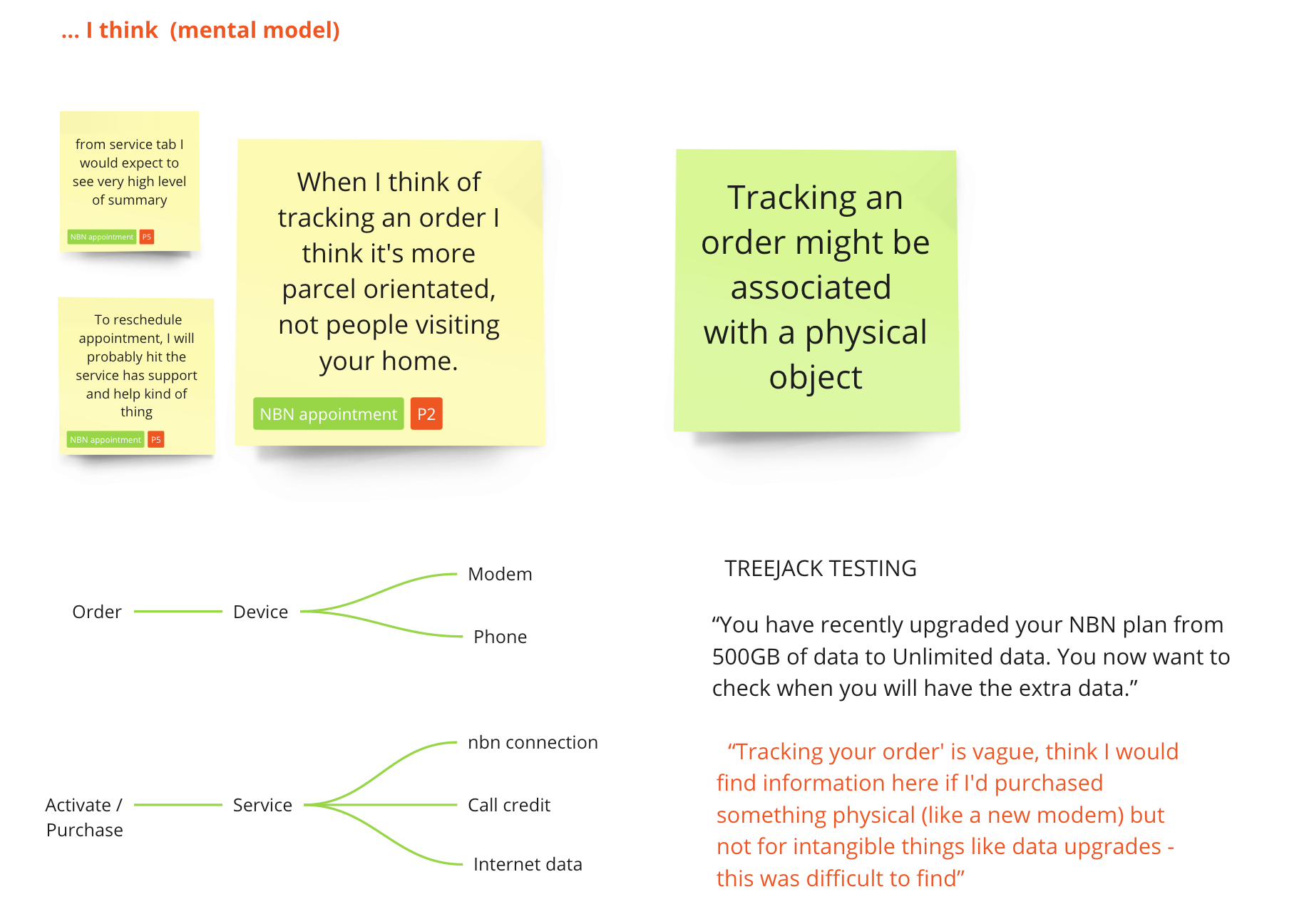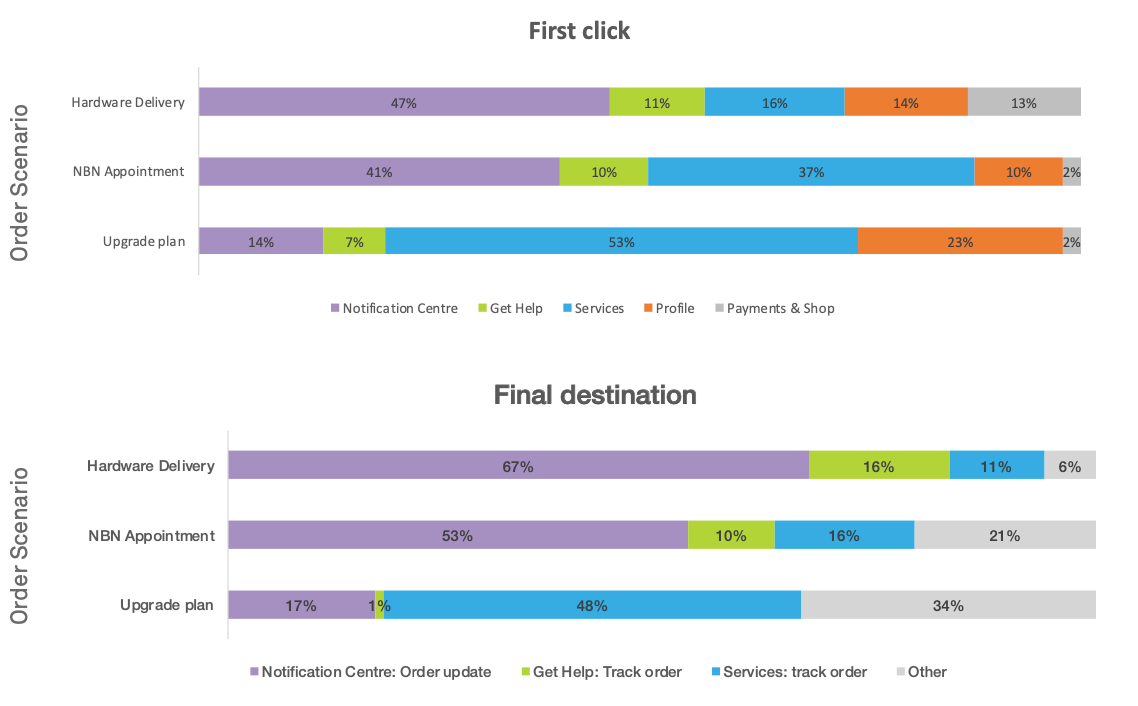User Research Lead
Customer Interviews | Usability Testing | Information Architecture | A/B Testing | Design Critique
The Problem
The order tracking experience in Telstra's customer account management app 'MyTelstra' was outdated. Designs were taken from the old world and re-skinned to look and feel new.
Additionally, limited thought had been put in the overall MyTelstra order tracking experience and how it catered to the many different services, scenarios and customer actions.
The Goal
Understand the customer mental models of different order tracking scenarios. Develop an intuitive journey which caters towards these mental models, allowing easy access and use.
Optimise the order tracker page to enhance accessibility, the information architecture, typographic hierarchy and overall ease of use to allow for quick digestion by the customer.
Overview
We needed to create a unified and instinctive order tracking experience across different Telstra services, allowing customers to intuitively access the order tracker during their unique journey. What complicated this is the vast number of services and scenarios this catered for, e.g. handset delivery, moving house, organising a technician to set up your internet (to name a few).
As the user research and experience lead, my task was to research and understand customer mental models associated with these differing scenarios to design an optimised overall experience and enhanced order tracker page design that allows for quick and easy digestion of key information.
Processes
User research
To understand customer use cases, it was important to perform exploratory research, through interviews and surveys. This would enable us to better understand users expectations on the overall experience for the order tracker as well as understand the individual nuances of each individual scenario and the mental models users have towards the different scenarios.
The key outcome was that customers hold distinctly different mental models for the different scenarios the order tracker was catering towards. For example, there was a clear association between an order tracker and the delivery of a modem or a mobile phone. However, this was less prominent with other scenarios such as upgrading a plan or setting up a home internet connection.
Ultimately, this research demonstrated a need to build an experience that catered towards different mental models and opened the path to further work on optimising entry points into the order tracker and reviewing the information architecture.


Usability Testing
One on one user testing sessions were performed remotely to further investigate our assumptions on customers differing mental models as well as test design aspects such as usability, find-ability and expectations of the flow.
The key outcomes from this round of usability testing were:
1. Users require clarity around the ‘why’ and purpose of key events stated on the order tracker that Telstra impose on them.
2. Users require language to be customer centric and easily digestible, not in confusing 'business language'
3. Users would expect to see a notification regarding plan changes or key milestones regarding their order. They would not intuitively navigate to the order tracker for scenarios other than physical delivery.
2. Users require language to be customer centric and easily digestible, not in confusing 'business language'
3. Users would expect to see a notification regarding plan changes or key milestones regarding their order. They would not intuitively navigate to the order tracker for scenarios other than physical delivery.
4. Iconography is powerful in helping users quickly and easily digest the meaning of each milestone

Tree Jack Testing
We had demonstrated the differing mental models and the need for an improved information architecture. Further validation from a larger number of users was necessary to provide stakeholders with greater statistical confidence to make these changes.
Tree jack testing was performed with 81 participants with the goals of:
1. Validating our insight that tracking a physical package, changing (upgrade/downgrade) a plan and appointments (NBN / Telstra technician) are separate within customers mental model
2. Validate the need to add additional entry points to the order tracker under ‘services’ to cater for these differing mental models, and reduce reliance on notifications.
The outcomes of this round of testing were:
1. The assumption of differing mental models for tracking hardware, appointments and changes was further validated.
2. For hardware tracking and appointments, there was a expectation of receiving ‘notifications’ mimicking the pattern of receiving email notifications for these types of events e.g. doctor’s appointment, package delivery.
3. For appointments and plan changes there was a high usage of the 'services section', however it was difficult for participants to find exactly what they wanted within this.
2. For hardware tracking and appointments, there was a expectation of receiving ‘notifications’ mimicking the pattern of receiving email notifications for these types of events e.g. doctor’s appointment, package delivery.
3. For appointments and plan changes there was a high usage of the 'services section', however it was difficult for participants to find exactly what they wanted within this.
And therefore the recommendations from testing were:
When building a singular order tracker that caters to multiple distinct events, we must consider:
- Catering entry points to different events
- Labelling, IA and UI at important points of the track order experience
- Up-to-date, ‘hyper relevant’ status of the order experience


Order tracker page optimisation - A/B Testing
Finally it was necessary to enhance the details of the actual order tracker page. Simple optimisations were made, such as reordering the typographic hierarchy to highlight important information and moving icons next to milestones and reducing their size to create a clear partnership and reduce the page scroll were made.
Some decisions required the rigour of customer testing to direct design decisions. For example, the removal of the 'progress line'. Removing it would give us major wins in terms of accessibility by increasing text size and reduce the burden on screen readers, however some felt removing the line would take away the 'linearity' of the process.
Through A/B testing, we found that the line has no impact on the perception of linearity and clearly labelling 'Step 1, Step 2' has a more positive impact.


Outcome
Through this iterative process of customer testing and design we delivered a holistic order tracker experience that is intuitively and easily accessed by any customer for any scenario. Furthermore, through our approach we were able to create a templatised order tracker page design which would allow for any future scenario to be covered. Reducing design and development time in the future.






